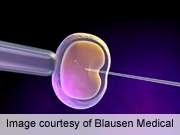Training model protects embryo transfer success rates

(HealthDay)—In an academic practice, a training model using ultrasound-guided embryo transfer (ET) results in similar live birth rates for reproductive endocrinology and infertility (REI) fellows and attending physicians, according to research published in the November issue of the American Journal of Obstetrics & Gynecology.
Jennifer L. Eaton, M.D., of the Duke University School of Medicine in Durham, N.C., and colleagues conducted a retrospective cohort study of women who underwent their first day-3, fresh, non-donor ET, between Oct. 1, 2005, and April 1, 2011, by an attending physician (760 patients) or a REI fellow (104 patients). ET was performed with the afterload method under ultrasound guidance.
The researchers found that, following ET, the live birth rate was 31 percent for the attending physician group and 34 percent for the REI fellow group (P = 0.65). After adjustment for potential confounding variables, no significant association was found between the type of physician performing ET and live birth rate.
"Our findings suggest that with appropriate supervision and consistent technique, REI fellows may obtain hands-on experience in ET without compromising a program's success rates," the authors write.
More information:
Abstract
Full Text (subscription or payment may be required)
Copyright © 2014 HealthDay. All rights reserved.




















